Genet (animal)
| Genet Temporal range: Pliocene–Recent PreꞒ Ꞓ O S D C P T J K Pg N | |
|---|---|
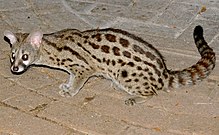 | |
| Scientific classification | |
| Domain: | Eukaryota |
| Kingdom: | Animalia |
| Phylum: | Chordata |
| Class: | Mammalia |
| Order: | Carnivora |
| Suborder: | Feliformia |
| Family: | Viverridae |
| Subfamily: | Genettinae |
| Genus: | Genetta Cuvier, 1816 |
| Type species | |
| Viverra genetta | |
| Species | |
| See text | |
A genet (pronounced /ˈdʒɛnɪt/ or /dʒəˈnɛt/) is a member of the genus Genetta, which consists of 17 species of small African carnivorans.[1][2] The common genet is the only genet present in Europe and occurs in the Iberian Peninsula, Italy and France.[3]
Genet fossils from the Late Miocene and later have been found at sites in Ethiopia, Kenya and Morocco.[4][5]
Classification
Genetta was named and described by Frédéric Cuvier in 1816.[6] The number of species in the genus is controversial. The following were proposed as valid in 2005:[1]
| Subgenus | Image | Name | Distribution and IUCN Red List status |
|---|---|---|---|
| Genetta |  | Common genet (G. genetta) (Linnaeus, 1758)[7] | LC[8]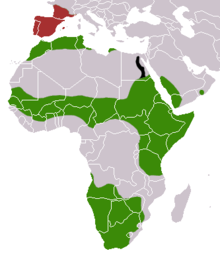 |
 | South African small-spotted genet (G. felina) (Thunberg), 1811[9] | ||
| Abyssinian genet (G. abyssinica) (Rüppell, 1835)[10] | DD[11] | ||
| Eugenetta |  | Cape genet (G. tigrina) (Schreber, 1778)[12] | LC[13]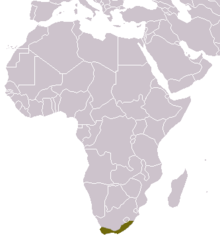 |
 | Angolan genet (G. angolensis) Bocage, 1882[14] | LC[15] | |
| Herpailuropoda | 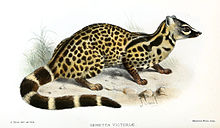 | Giant forest genet (G. victoriae) Thomas, 1901[16] | LC[17]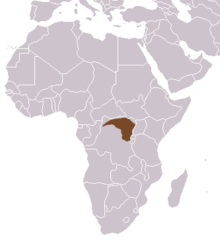 |
 | Hausa genet (G. thierryi) Matschie, 1902[18] | LC[19] | |
| Johnston's genet (G. johnstoni) Pocock, 1907[20] | NT[21]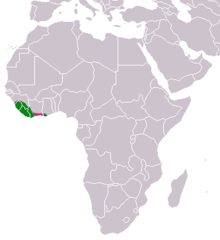 | ||
| Bourlon's genet (G. bourloni) Gaubert, 2003[22] | |||
| Pardogale | 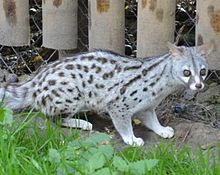 | Pardine genet (G. pardina) Geoffroy Saint-Hilaire, 1832[23] | LC[24]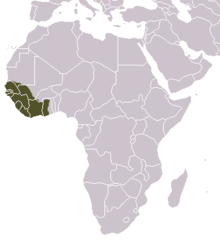 |
| King genet (G. poensis) Waterhouse, 1838[25] | DD[26]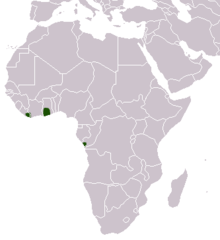 | ||
| Prionailuropoda |  | Rusty-spotted genet (G. maculata) (Gray, 1830)[27] | LC[28]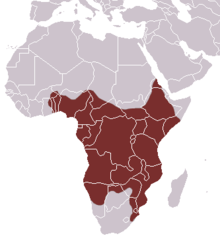 |
| Letaba genet (G. letabae) Thomas and Schwann, 1906[29] | |||
| Schouteden's genet (G. schoutedeni) Crawford-Cabral, 1970[30] | |||
| Leptailuropoda | 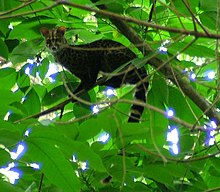 | Servaline genet (G. servalina) Pucheran, 1855[31] | LC[32] |
 | Crested servaline genet (G. cristata) Hayman, 1940[33] | VU[34]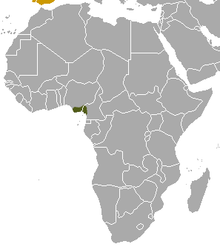 | |
| Osbornictis |  | Aquatic genet (G. piscivora) (Allen), 1919[35] | NT[36] |
Extinct species
- †Genetta nyakitongwer – Early Pleistocene of Kenya[37]
- †Genetta plesictoides – Late Pleistocene of Cyprus[38]
Genetta and Poiana are estimated to have diverged about 9.5 to 13.3 million years ago.[39] Genetta species are estimated to have diverged at least 8.5 million years ago starting with the Hausa genet, followed by the giant genet 3.98 to 6.01 million years ago.[40]
Characteristics

Genets are slender cat-like animals with a long body, a long ringed tail, large ears, a pointed muzzle and partly retractile claws. Their fur is spotted, but melanistic genets have also been recorded. They have musk glands and anal sacs.[41][42] They also have perineal glands.[43]
All genet species have a dark stripe along the spine; they differ in fur color and spot pattern. Their size varies between species from 40.9 to 60 cm (16.1 to 23.6 in) in head-to-body length with 40 to 47 cm (16 to 19 in) long tails; their tails are almost as long as head and body.[1] They have large eyes with elliptical pupils; the iris is about the color of the fur. They can move their eyes within their sockets to a limited extent, and move their heads to focus on moving objects. Their pinnae have a fine layer of hair inside and outside. They can move the pinnae by about 80° from pointing forward to the side, and also from an erect position to pointing downwards. Their rhinarium is important for both sensing smell and touch.[44]
Distribution and habitat
All genet species are indigenous to Africa. The common genet was introduced to southwestern Europe during historical times.[1] It was brought from the Maghreb to Spain as a semi-domestic animal about 1000 to 1500 years ago, and from there spread to southern France and Italy.[45] In Africa, it inhabits wooded habitats north of the Sahara, in savanna zones south of the Sahara to southern Africa and along the coast of Arabia, Yemen and Oman.[46]
The Cape genet is endemic to fynbos, grassland and coastal forests in South Africa.[47]
The South African small-spotted genet lives in woodland savanna, grassland, thickets, dry vlei areas in Angola, Namibia, South Africa and Zambia.[1]
The rusty-spotted genet is widely distributed in sub-Saharan woodland savannah, savannah-forest mosaic, rain forest and montane forest up to an elevation of 3,400 m (11,200 ft) in Ethiopia.[48]
The pardine genet lives in primary and secondary rainforests, gallery forests, moist woodlands, but also in plantations and suburban areas ranging from Senegal to the Volta River in Ghana.[49]
The Abyssinian genet has been recorded in montane dry forest up to 3,750 m (12,300 ft) in Ethiopia.[50]
The King genet is restricted to rainforest in the Congo Basin, Bioko Island, Ghana and Liberia.[1]
The servaline genet lives in Central African lowland forests to high-altitude bamboo forest and coral rag thicket on Zanzibar.[51]
The Angolan genet inhabits open miombo forest from Angola to central Tanzania.[52]
The giant forest genet lives in rainforests of the Democratic Republic of the Congo and western Uganda.[53]
The Hausa genet inhabits savannah and moist woodlands in West Africa.[1]
G. letabae has been recorded in woodland savannah in Lesotho, Eswatini, Mozambique, Namibia and South Africa.[1]
Johnston's genet inhabits dense rainforest in Upper Guinea.[54]
The aquatic genet inhabits rainforests between the Congo River and the Rift Valley.[55]
The crested servaline genet is endemic to Nigeria and Cameroon, where it inhabits scrub and primary deciduous forests.[56]
Schouteden's genet inhabits rainforest, woodland savannah and savannah-forest mosaic in tropical Africa.[1]
Bourlon's genet lives only in the Upper Guinean rainforests in West Africa.[22]
Ecology and behavior

Genets are highly agile, have quick reflexes and exceptional climbing skills. They are the only viverrids able to stand on their hind legs. They walk, trot, run, climb up and down trees, and jump. They live on the ground, but also spend much of their time in trees. They are considered solitary, except during mating and when females have offspring.[44]
They are omnivorous and opportunistically catch invertebrates and small vertebrates, but also feed on plants and fruit. Aquatic genets feed mainly on fish.[41] Angolan genets are thought to feed on grasshoppers and other arthropods.[52] Johnston's genet probably feeds mainly on insects.[57]
In 2014, a camera trap in the Hluhluwe–Imfolozi Park captured a large spotted genet riding on the back of two different buffalo and a rhinoceros. This was the first time a genet was recorded hitch-hiking.[58]
Females have up to five young in a litter.[41] They rear their young alone.[44]
Common genet females become sexually mature at the age of two years. After copulation, the gestation period lasts for 10 to 11 weeks.[3] They are diestrous and give birth twice a year, during spring and late summer to autumn.[59] Captive common genets have been known to live up to 13 years.[60] A male genet lived for 22.7 years in captivity.[61]
Threats

Loss of habitat due to deforestation and conversion of land to agriculture is a major threat for the crested servaline genet and Johnston's genet. Both genet species are also hunted for meat and skins. They are listed as Vulnerable on the IUCN Red Lists.[62][63] These are also major threats for Bourlon's genet, which is classified as Near Threatened.[64]
The aquatic genet may be affected by hunting, but major threats have not yet been identified. It is listed as Near Threatened on the IUCN Red List.[65]
The king genet and the Abyssinian genet are so poorly known that threats cannot be identified. Both are listed as Data Deficient on the IUCN Red Lists.[66][67]
The remaining genet species are not considered threatened and are listed as Least Concern on the IUCN Red Lists.[68][69][70][71][72][73][74][75]
Etymology
The etymological origin of the word 'genet' is uncertain; it may be a derivation of the Arabic name djarnet.[3] The English word comes from Old French 'genete', which came from Spanish 'gineta'.[76]
As pets
Pet genets are mostly common genets, rusty-spotted genets or Cape genets.[77]
References
- ^ a b c d e f g h i Gaubert, P.; Taylor, P. J. & Veron, G. (2005). "Integrative taxonomy and phylogenetic systematics of the genets (Carnivora, Viverridae, Genetta): a new classification of the most speciose carnivoran genus in Africa" (PDF). In Huber, B. A.; Sinclair, B. J. & Lampe, K.-H. (eds.). African Biodiversity: Molecules, Organisms, Ecosystems. Proceedings of the 5th International Symposium of Tropical Biology, Museum König, Bonn. Springer. pp. 371–383.
- ^ Wozencraft, W. C. (2005). "Genetta". In Wilson, D. E.; Reeder, D. M. (eds.). Mammal Species of the World: A Taxonomic and Geographic Reference (3rd ed.). Johns Hopkins University Press. pp. 554–557. ISBN 978-0-8018-8221-0. OCLC 62265494.
- ^ a b c Larivière, S.; Calzada, J. (2001). "Genetta genetta" (PDF). Mammalian Species. 680: 1–2. doi:10.1644/1545-1410(2001)680<0001:gg>2.0.co;2. S2CID 198968676. Archived from the original (PDF) on 2016-03-03. Retrieved 2012-12-30.
- ^ Ginsburg, L. (1977). "Les carnivores du Miocène de Beni Mellal (Maroc)". Géologie Méditerranéenne (in French). 4 (3): 225–239. doi:10.3406/geolm.1977.1005.
- ^ Werdelin, L.; Peigné, S. (2010). "Carnivora". In Werdelin, L.; Sanders, W. J. (eds.). Cenozoic Mammals of Africa. Berkeley, California: University of California Press. pp. 603–657. ISBN 9780520257214.
- ^ Cuvier, F. (1816). Cuvier, G. (ed.). Le règne animal distribué d'après son organisation, pour servir de base à l'histoire naturelle des animaux et d'introduction à l'anatomie comparée. Vol. I. Paris: Deterville.
- ^ Linnaeus, C. (1758). "Viverra genetta". Systema naturæ per regna tria naturæ, secundum classes, ordines, genera, species, cum characteribus, differentiis, synonymis, locis 1 (10th ed.). Stockholm: Laurentius Salvius.
- ^ Gaubert, P.; Carvalho, F.; Camps, D. & Do Linh San, E. (2015). "Genetta genetta". IUCN Red List of Threatened Species. 2015: e.T41698A45218636.
- ^ Thunberg, C. P. (1811). "Beskrifning och teckning pa Viverra felina". Kungliga Swenska Wetenskaps Academiens Handlingar: 165–168.
- ^ Rüppell, E. (1835). "Viverra abyssinica. Rüppell". Neue Wirbelthiere zu der Fauna von Abyssinien gehörig. Frankfurt: Siegmund Schmerber.
- ^ Gaubert, P.; Duckworth, J.W. & Do Linh San, E. (2016). "Genetta abyssinica". IUCN Red List of Threatened Species. 2016: e.T8994A45198149.
- ^ Schreber, J. C. D. (1778). "Die Bisamkaze Viverra tigrina". Die Säugethiere in Abbildungen nach der Natur mit Beschreibungen. Vol. Dritter Theil. Erlangen: Walther. pp. 425–426.
- ^ Gaubert, P. & Do Linh San, E. (2015). "Genetta tigrina". IUCN Red List of Threatened Species. 2015: e.T41702A45219459.
- ^ Bocage, J. V. B. (1882). "Liste de mammifères envoyés de Caconda Angola". Jornal de Sciências, Mathemáticas, Physicas e Naturaes de Lisboa. 1. 9 (33): 25–29.
- ^ Gaubert, P.; Fischer, C.; Hausser, Y. & Do Linh San, E. (2016). "Genetta angolensis". IUCN Red List of Threatened Species. 2016: e.T41696A45218468.
- ^ Thomas, O. (1901). "On the more notable Mammals obtained by Sir Harry Johnston in the Uganda Protectorate". Proceedings of the Zoological Society of London. II: 85–90. doi:10.1111/j.1469-7998.1901.tb08165.x.
- ^ Gaubert, P.; Dinets, V. & Do Linh San, E. (2016). "Genetta victoriae". IUCN Red List of Threatened Species. 2016: e.T41703A45219531.
- ^ Matschie, P. (1902). "Über die individuellen und geographischen Abänderungen der Ginsterkatzen". Verhandlungen des V. Internationalen Zoologen-Congresses zu Berlin, 12.–16. August 1901. Jena: Gustav Fischer. pp. 1128–1145.
- ^ Gaubert, P. & Do Linh San, E. (2015). "Genetta thierryi". IUCN Red List of Threatened Species. 2015: e.T41701A45219325.
- ^ Pocock, R. I. (1907). "Report upon a small collection of Mammalia brought from Liberia by Mr Leonard Leighton". Proceedings of the Zoological Society of London. 77 (May to December): 1037–1047. doi:10.1111/j.1469-7998.1907.tb06966.x.
- ^ Gaubert, P. & Do Linh San, E. (2016). "Genetta johnstoni". IUCN Red List of Threatened Species. 2016: e.T8997A45198265.
- ^ a b Gaubert, P. (2003). "Description of a new species of genet (Carnivora; Viverridae; genus Genetta) and taxonomic revision of forest forms related to the Large-spotted Genet complex". Mammalia. 67 (1): 85–108. doi:10.1515/mamm.2003.67.1.85. S2CID 84351854.
- ^ Geoffroy Saint-Hilaire, I. (1832). "Descriptions d'une nouvelle espèce du genre Genette. Genetta. Cuv.". Études Zoologiques: Ouvrage comprenant l'histoire et la description d'un grand nombre d'animaux récemment découverts et des observations nouvelles sur plusieurs genres déjà connus. Paris: Lequien Fils. p. 73.
- ^ Gaubert, P. & Do Linh San, E. (2016). "Genetta pardina". IUCN Red List of Threatened Species. 2016: e.T136437A45221360.
- ^ Waterhouse, G. R. (1838). "On some New Species of Mammalia from Fernando Po". Proceedings of the Zoological Society of London: 57–61.
- ^ Gaubert, P. & Do Linh San, E. (2015). "Genetta poensis". IUCN Red List of Threatened Species. 2015: e.T136435A45221269.
- ^ Gray, J. E. (1828). "Viverra maculata". Spicilegia zoologica: original figures and short systematic descriptions of new and unfigured animals. London: Treuttel, Wurtz & Co. p. 9.
- ^ Angelici, F.M.; Gaubert, P. & Do Linh San, E. (2016). "Genetta maculata". IUCN Red List of Threatened Species. 2016: e.T41699A45218948.
- ^ Thomas, O. & Schwann, H. (1906). "The Rudd Exploration of South Africa.—IV. List of Mammals obtained by Mr. Grant at Knysna". Proceedings of the Zoological Society of London. 76 (1–2): 159–168. doi:10.1111/j.1469-7998.1906.tb08427.x.
- ^ Crawford-Cabral, J. (1970). "As genetas da Africa Central". Boletim do Instituto de Investigação Científica de Angola. 7: 3–23.
- ^ Pucheran, J. (1855). "Genetta servalina". Revue et magasin de zoologie pure et appliquée. II. 7 (Mars): 154.
- ^ Gaubert, P.; De Luca, D.W.; Rovero, F. & Do Linh San, E. (2016). "Genetta servalina". IUCN Red List of Threatened Species. 2016: e.T41700A97163789. Retrieved 30 October 2018.
- ^ Hayman, R. W. (1940). "The Mammals of the North Gameroons Forest Area. Being the Results of the Percy Sladen Expedition to the Mamfe Division of the British Cameroons". In Sanderson, I. T. (ed.). The Transactions of the Zoological Society of London. Vol. 24. pp. 623–726.
- ^ Gaubert, P.; Angelici, F.M. & Do Linh San, E. (2015). "Genetta cristata". IUCN Red List of Threatened Species. 2015: e.T8998A45198406.
- ^ Allen, J. A. (1919). "Preliminary notes on African carnivora". Journal of Mammalogy. 1 (1): 23–31. doi:10.2307/1373716. JSTOR 1373716.
- ^ Gaubert, P. & Do Linh San, E. (2015). "Genetta piscivora". IUCN Red List of Threatened Species. 2015: e.T15628A45201673.
- ^ Werdelin, Lars; Lewis, Margaret E. (2013). Koobi Fora Research Project. Volume 7. The Carnivora. San Francisco: California Academy of Sciences. p. 333.
- ^ Theodorou, G.E.; Roussiakis, S.I.; Athanassiou, A.; Giaourtsakis, I.; Panayides, I. (2007). "A Late Pleistocene endemic genet (Carnivora, Viverridae) from Aghia Napa, Cyprus". Bulletin of the Geological Society of Greece. 40: 201–208. doi:10.12681/bgsg.16514.
- ^ Gaubert, P. & Veron, G. (2003). "Exhaustive sample set among Viverridae reveals the sister-group of felids: the linsangs as a case of extreme morphological convergence within Feliformia". Proceedings of the Royal Society of London B: Biological Sciences. 270 (1532): 2523–2530. doi:10.1098/rspb.2003.2521. PMC 1691530. PMID 14667345.
- ^ Gaubert, P.; Fernandes, C. A.; Bruford, M. W. & Veron, G. (2004). "Genets (Carnivora, Viverridae) in Africa: an evolutionary synthesis based on cytochrome b sequences and morphological characters". Biological Journal of the Linnean Society. 81 (4): 589–610. doi:10.1111/j.1095-8312.2004.00309.x.
- ^ a b c Kingdon, J. 1997. The Kingdon Field Guide to African Mammals. Academic Press, San Diego, California.
- ^ Crawford-Cabral, J. (1981). Análise de dados craniométricos no género Genetta G. Cuvier (Carnivora, viverridae). Lisboa: Junta de Investigações Científicas do Ultramar, Centro de Zoologia.
- ^ Roeder, Jean-Jacques. "Marking behaviour and olfactory recognition in genets (Genetta genetta L., Carnivora-Viverridae)." Behaviour 72.3 (1980): 200-210.
- ^ a b c Wemmer, C. M. (1977). Comparative Ethology of the Large Spotted Genet (Genetta genetta) and Some Related Viverrids (PDF). Washington: Smithsonian Institutional Press.
- ^ Morales, A. (1994). "Earliest genets in Europe". Nature. 370 (6490): 512–513. Bibcode:1994Natur.370..512M. doi:10.1038/370512b0. S2CID 4338977.
- ^ Delibes, M. & Gaubert, P. (2013). "Genetta genetta Common Genet (Small-spotted Genet)". In Kingdon, J. & Hoffmann, M. (eds.). The Mammals of Africa. Vol. V. Carnivores, Pangolins, Equids and Rhinoceroses. London, UK: Bloomsbury. pp. 223–229.
- ^ Gaubert, P. (2013). Genetta tigrina Cape Genet. In: J. Kingdon and M. Hoffmann (eds.) The Mammals of Africa. V. Carnivores, Pangolins, Equids and Rhinoceroses, pp. 247–249. Bloomsbury, London, UK.
- ^ Angelici, F.M. and Gaubert, P. (2013). Genetta maculata Large-spotted Genet (Blotched Genet). In: J. Kingdon and M. Hoffmann (eds.) The Mammals of Africa. V. Carnivores, Pangolins, Equids and Rhinoceroses, pp. 232–236. Bloomsbury, London, Uk.
- ^ Gaubert, P. and Dunham, A. E. (2013). Genetta pardina Pardine Genet (West African Large-spotted Genet). In: J. Kingdon and M. Hoffmann (eds.) The Mammals of Africa. V. Carnivores, Pangolins, Equids and Rhinoceroses, pp. 237–238. Bloomsbury, London, UK.
- ^ Diaz Behrens, G. and Van Rompaey, H. (2002). The Ethiopian Genet, Genetta abyssinica (Rüppell 1836) (Carnivora, Viverridae): ecology and phenotypic aspects. Small Carnivore Conservation 27: 23–28.
- ^ Van Rompaey, H. and Colyn, M. (2013). Genetta servalina Servaline Genet. In: J. Kingdon and M. Hoffmann (eds.) The Mammals of Africa. V. Carnivores, Pangolins, Equids and Rhinoceroses, pp. 242–245. Bloomsbury, London, UK.
- ^ a b Crawford-Cabral, J. (2013). Genetta angolensis Miombo Genet. In: J. Kingdon and M. Hoffmann (eds.) The Mammals of Africa. V. Carnivores, Pangolins, Equids and Rhinoceroses, pp. 218–220. Bloomsbury, London, UK.
- ^ Van Rompaey, H. and Colyn, M. /2013). Genetta victoriae Giant Genet. In: J. Kingdon and M. Hoffmann (eds.) The Mammals of Africa. V. Carnivores, Pangolins, Equids and Rhinoceroses, pp. 249–250. Bloomsbury, London, UK.
- ^ Gaubert, P., Veron, G., Colyn, M., Dunham, A., Shultz, S. and Tranier, M. (2002). A reassessment of the distribution of the rare Genetta johnstoni (Viverridae, Carnivora) with some newly discovered specimens. Mammal Review 32: 132–144.
- ^ Van Rompaey, H. and Colyn, M. /2013). Genetta piscivora Aquatic Genet. In: J. Kingdon and M. Hoffmann (eds.) The Mammals of Africa. V. Carnivores, Pangolins, Equids and Rhinoceroses, pp. 239–240. Bloomsbury, London, UK.
- ^ Angelici, F. M. and Luiselli, L. (2005). Habitat associations and dietary relationships between two genets, Genetta maculata and Genetta cristata. Revue d'Écologie (La Terre et la Vie) 60: 341–354.
- ^ Dunham, A. E. and Gaubert, P. (2013). Genetta johnstoni Johnston's Genet. In: J. Kingdon and M. Hoffmann (eds.) The Mammals of Africa. V. Carnivores, Pangolins, Equids and Rhinoceroses, pp. 229–231. Bloomsbury, Amsterdam, the Netherlands.
- ^ Luhdo, Z. (2014). Camera Traps Capture A Hitch Hiking Genet. Wildlife ACT, South Africa.
- ^ Zabala, Jabi and Iñigo Zuberogoitia. (2010). Late summer-early winter reproduction in common genets, Genetta genetta. Mammalia 74: 89–91.
- ^ Flower, Major Stanley S. (1931). "Contributions to our Knowledge of the Duration of Life in Vertebrate Animals. V. Mammals". Proceedings of the Zoological Society of London. 101 (1): 145–234. doi:10.1111/j.1469-7998.1931.tb06192.x.
- ^ Weigl, R. (2005). Longevity of Mammals in Captivity: From the Living Collections of the World: A List of Mammalian Longevity in Captivity. Kleine Senckenberg-Reihe 48. E. Schweizerbart'sche, Stuttgart
- ^ Gaubert, P.; Angelici, F.M.; Do Linh San, E. (2015). "Genetta cristata". IUCN Red List of Threatened Species. 2015: e.T8998A45198406. doi:10.2305/IUCN.UK.2015-4.RLTS.T8998A45198406.en. Retrieved 12 November 2021.
- ^ Gaubert, P.; Do Linh San, E. (2016). "Genetta johnstoni". IUCN Red List of Threatened Species. 2016: e.T8997A45198265. doi:10.2305/IUCN.UK.2016-1.RLTS.T8997A45198265.en. Retrieved 12 November 2021.
- ^ Gaubert, P.; Greengrass, E.J.; Do Linh San, E. (2015). "Genetta bourloni". IUCN Red List of Threatened Species. 2015: e.T136223A45220931. doi:10.2305/IUCN.UK.2015-4.RLTS.T136223A45220931.en. Retrieved 12 November 2021.
- ^ Gaubert, P.; Do Linh San, E. (2015). "Genetta piscivora". IUCN Red List of Threatened Species. 2015: e.T15628A45201673. doi:10.2305/IUCN.UK.2015-4.RLTS.T15628A45201673.en. Retrieved 12 November 2021.
- ^ Gaubert, P.; Do Linh San, E. (2015). "Genetta poensis". IUCN Red List of Threatened Species. 2015: e.T136435A45221269. doi:10.2305/IUCN.UK.2015-4.RLTS.T136435A45221269.en. Retrieved 12 November 2021.
- ^ Gaubert, P.; Duckworth, J.W.; Do Linh San, E. (2016). "Genetta abyssinica". IUCN Red List of Threatened Species. 2016: e.T8994A45198149. doi:10.2305/IUCN.UK.2016-1.RLTS.T8994A45198149.en. Retrieved 12 November 2021.
- ^ Gaubert, P.; Fischer, C.; Hausser, Y.; Do Linh San, E. (2016). "Genetta angolensis". IUCN Red List of Threatened Species. 2016: e.T41696A45218468. doi:10.2305/IUCN.UK.2016-1.RLTS.T41696A45218468.en. Retrieved 12 November 2021.
- ^ Gaubert, P.; Carvalho, F.; Camps, D.; Do Linh San, E. (2015). "Genetta genetta". IUCN Red List of Threatened Species. 2015: e.T41698A45218636. doi:10.2305/IUCN.UK.2015-4.RLTS.T41698A45218636.en. Retrieved 12 November 2021.
- ^ Angelici, F.M.; Gaubert, P.; Do Linh San, E. (2016). "Genetta maculata". IUCN Red List of Threatened Species. 2016: e.T41699A45218948. doi:10.2305/IUCN.UK.2016-1.RLTS.T41699A45218948.en. Retrieved 12 November 2021.
- ^ Gaubert, P.; De Luca, D.W.; Rovero, F.; Do Linh San, E. (2016). "Genetta servalina". IUCN Red List of Threatened Species. 2016: e.T41700A97163789. doi:10.2305/IUCN.UK.2016-1.RLTS.T41700A97163789.en. Retrieved 12 November 2021.
- ^ Gaubert, P.; Do Linh San, E. (2015). "Genetta thierryi". IUCN Red List of Threatened Species. 2015: e.T41701A45219325. doi:10.2305/IUCN.UK.2015-4.RLTS.T41701A45219325.en. Retrieved 12 November 2021.
- ^ Gaubert, P.; Do Linh San, E. (2015). "Genetta tigrina". IUCN Red List of Threatened Species. 2015: e.T41702A45219459. doi:10.2305/IUCN.UK.2015-4.RLTS.T41702A45219459.en. Retrieved 12 November 2021.
- ^ Gaubert, P.; Dinets, V.; Do Linh San, E. (2016). "Genetta victoriae". IUCN Red List of Threatened Species. 2016: e.T41703A45219531. doi:10.2305/IUCN.UK.2016-1.RLTS.T41703A45219531.en. Retrieved 12 November 2021.
- ^ Gaubert, P.; Do Linh San, E. (2016). "Genetta pardina". IUCN Red List of Threatened Species. 2016: e.T136437A45221360. doi:10.2305/IUCN.UK.2016-1.RLTS.T136437A45221360.en. Retrieved 12 November 2021.
- ^ "Genet". Douglas Harper, Online Etymology Dictionary. 2001–2015.
- ^ Van Rompaey, H. & & Colyn, M. (1998). "A new servaline genet (Carnivora, Viverridae) from Zanzibar island". South African Journal of Zoology. 33 (1): 42–46. doi:10.1080/02541858.1998.11448452.
Further reading
- Virgos, E., Llorente, M., & Cortes, Y. (1999). "Geographical variation in genet (Genetta genetta L) diet: a literature review". Mammal Review 29(2): 117–126.
- Camps, D. (2011). "Resting site selection, characteristics and use by the common genet Genetta genetta (Linnaeus 1758)". Mammalia 75: 23–29. doi:10.1515/MAMM.2010.061.
External links


- Animal Diversity Web: Genetta genetta
- African Wildlife Foundation: Genet
- v
- t
- e
- Kingdom: Animalia
- Phylum: Chordata
- Class: Mammalia
- Infraclass: Eutheria
- Superorder: Laurasiatheria
Feliformia ("cat-like" carnivorans) | |||||||||||||||||||||||||||||||||||||||||||||||||||||||||||
|---|---|---|---|---|---|---|---|---|---|---|---|---|---|---|---|---|---|---|---|---|---|---|---|---|---|---|---|---|---|---|---|---|---|---|---|---|---|---|---|---|---|---|---|---|---|---|---|---|---|---|---|---|---|---|---|---|---|---|---|
| |||||||||||||||||||||||||||||||||||||||||||||||||||||||||||
| |||||||||||||||||||||||||||||||
| |||||||||||||||||||||||||||||||||||||||||||||||||||||||||||||
Caniformia ("dog-like" carnivorans) | |||||||||||||||||||||||||||||||||||||||||||||||||||||
|---|---|---|---|---|---|---|---|---|---|---|---|---|---|---|---|---|---|---|---|---|---|---|---|---|---|---|---|---|---|---|---|---|---|---|---|---|---|---|---|---|---|---|---|---|---|---|---|---|---|---|---|---|---|
| |||||||||||||||||||||||||||||||||||||||||||||||||||||
Pinnipedia (seals) | |||||||||||||||||||||||||||||||||||||||||||||||||
|---|---|---|---|---|---|---|---|---|---|---|---|---|---|---|---|---|---|---|---|---|---|---|---|---|---|---|---|---|---|---|---|---|---|---|---|---|---|---|---|---|---|---|---|---|---|---|---|---|---|
| |||||||||||||||||||||||||||||||||||||||||||||||||
| |||||||||||||||||||||||||||||||
| |||||||||||||||||||||||||||||||||||||||||||||||||||||||||||||||












